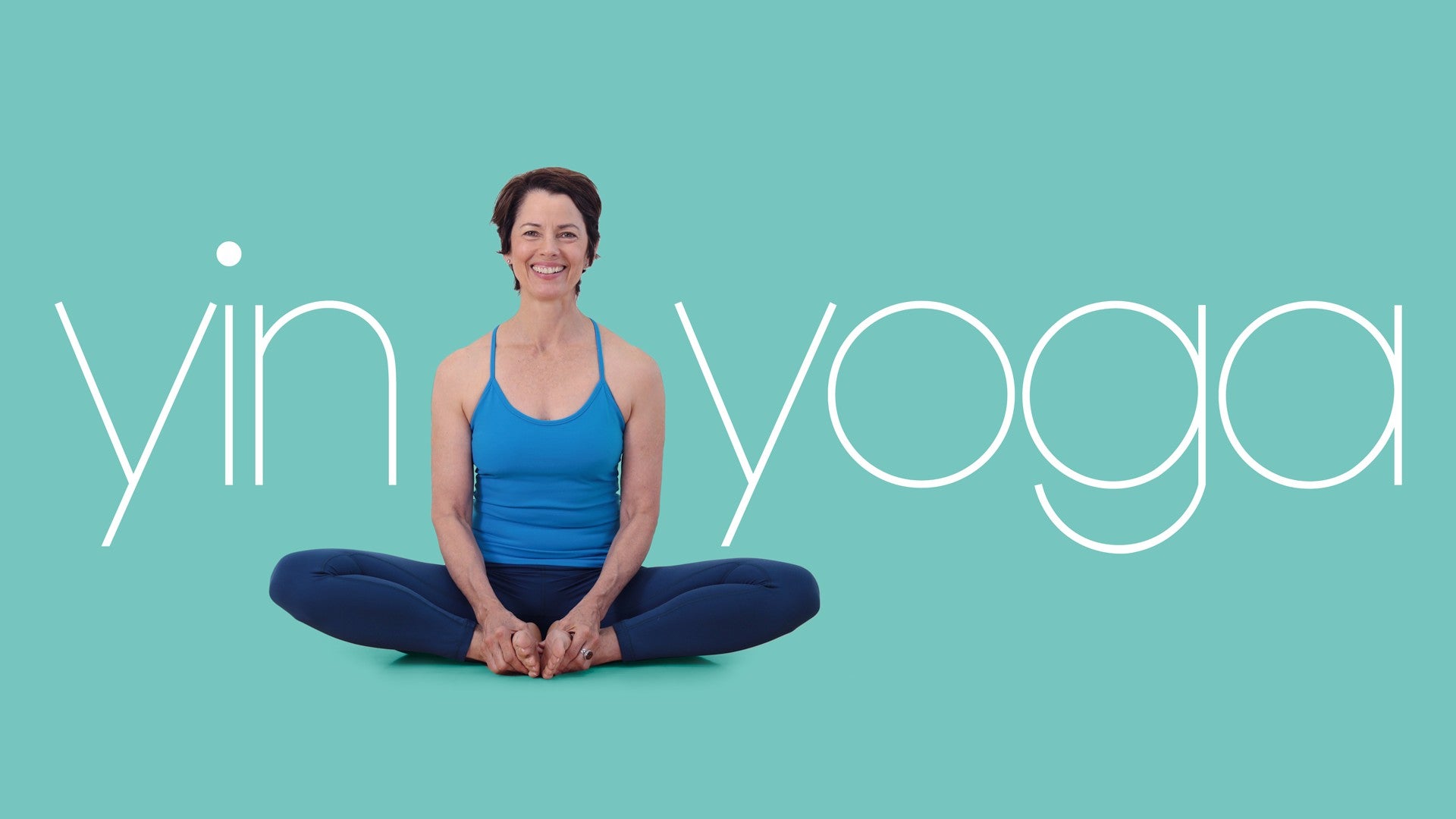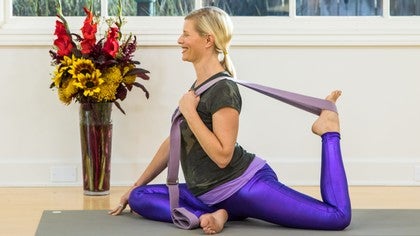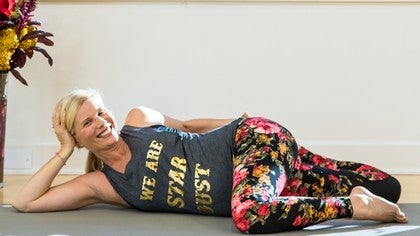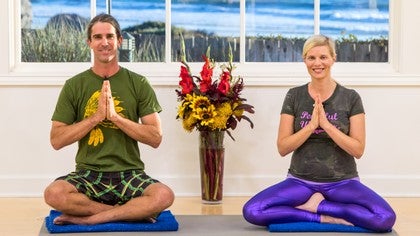Description
Transcript
Read Full Transcript
Hi, y'all, I'm glad you're here to join me. So let's get started in butterfly pose. So we're going to come into a forward fold with the soles of the feet together and the knees wide. And you could pull your heels in close if you want. I might tell you to make more of a diamond shape with the legs if that feels okay.
And then we're just going to start to come forward into our forward fold. We'll be here about two minutes. So I'm not using any props today for my forward fold. You certainly could if you needed. Something feels like it needs to be supported.
But I'm choosing to just do this pose without props today because I like to do the pose in different ways. So sometimes I use props for this pose, but I'm not today. So if the weight of the head is too much, you might prop it up. Sometimes if I'm at home just doing this pose like in my living room and I don't have props nearby, I'll just grab a pillow off the couch or something. You also could just rest your head in your hands.
And just notice where you're feeling this. And sometimes the answer is everywhere. That's okay. But use your yogi mind, tune your yogi mind a little bit, and see if you can be a bit more specific. So places you might be feeling this are the inner thighs, the groin area, the outer hip.
So sometimes people feel this is like a glute stimulation. And then certainly you might be feeling this in the spine. I'm actually feeling it in all three places. But that doesn't mean I'm doing a better version of the pose. It just means that that's where I feel it.
So from here, we're going to move into dragonfly. So we're going to start to ease the body up. I'm not going to come all the way up because I'm going right into dragonfly. I'm just going to extend my legs out. So wide legged pose, I'm going to kind of scooch my hips forward and then just start to come forward for about two minutes here.
So a couple of things you could do with props here. Certainly if the backs of the legs are really tight, your hamstrings are really tight, you could bring blankets or towels or blocks underneath the knees. I think a rolled up towel on each side works really nicely. That's just going to support the hamstring or support the back of the knee a little bit and alleviate some of the stretch of the hamstring. You also could lean into a bolster or a block.
If you aren't quite low, you could just stay up too on the hands with the arms straight. You notice since we're doing this in a yin fashion, I'm not flexing my feet. I'm really just trying to let my tissues hang on the structure of my bones. It's fine if the back is rounded. So this is probably back of the thighs, hamstring stretch for some of you.
Some of you may be a deep inner thigh groin stretch and hopefully most of us are getting a spinal stretch as well. I do use a little bit of my muscle in my legs to internally rotate or externally rotate the thigh bones just a bit, like little micro-movements. It's like I'm turning the toes in or turning the toes out and it fine-tunes the pose. I find a deeper spot. So we're just going to start to ease the body up.
Just take your time because we've been down for a while and let yourself acclimate. After this pose, I like to help my knees bend, so I'm going to use my hands to bend my knees. It just feels good. Then we're going to come onto an all fours position. Take all the time you need to get there.
So I'm in an all fours position and then I'm going to come for about a minute into puppy pose or anahatasana. I want to let some of you know before I start the minute is that you could do this pose for 30 seconds, one arm at a time. Some people this feels better. I'm going to do it for the full minute with both arms out. So for a minute here, and notice I'm resting my head down.
Some of you may not. So you could choose to just prop your head up with your forearms or a block. And everybody's going to probably tilt the pelvis differently in this. I'm actually lifting my sitz bones a little bit and encouraging that arch of my back. I like that.
I'm dropping my chest through and I'm feeling a nice opening in the front of the chest armpit area. For the last little bit, I might even start to bring my chin towards the floor. And then just start to slowly come out. You might just slide your elbows back until you can push into the elbows and use the arms. Let's just rest in a little child's pose for just a moment.
Let give yourself the nicest little wobble, just a little movement. The movement always reminds me, helps me remember that the spine is fluid. It's a structurally sound place in the body, but it's got fluidity to it. So I'm coming up and we're going to come into frog pose. So this class is really, it's a series for the pelvis, the inner thighs, the diaphragm.
So we're coming next into frog pose. So I'm going to use a blanket and I'm going to spread it all the way out. Coming into frog pose, I'm going to bring the bolster forward. I like a bolster to support my upper body, my torso. So my knees are going to come wide and the blanket is helping to support the inner knee just so that there's padding on the inner knee.
And then I'm just going to come forward onto the forearms and we'll be here about two minutes. So with frog, you could drop the hips back. You could just do this as a wide knee child's pose. So you can drop the pelvis back or some people can come all the way forward and some people can actually just bring their torso all the way down. They're more like a squished frog, but I'm going to be back.
That's where I'm getting my inner thigh and groin stretch. So you got to maneuver your own bones to find these poses. We're looking for the target area. The target area in this pose is the inner thigh and the groins. So think of the pose in a functional way.
So a deep stretch usually for the inner thigh groin. This can be an intense pose. It is for me. And I'm making little movements. I mean they're, I'm staying in a spot.
I'm lingering in a place, but I'm micro moving to just find these, they're like, they're lines of energy. But if that's too weird for you, just think of it as lines of stretching. And I'm actually really feeling the, the inner thighs, the groin open up and the pelvis be allowed to just drop in a little deeper. Sometimes you actually get to the spot where you drop in so much that you lose the stretch. That's not happening to me, but if it does, just move again.
And notice if the stretch is more intense on one side or the other, and then we'll just ease out. So I'm going to bring my arms off the bolster first. I'm not, I'm trying not to, I'm trying to use my upper body to come out of it. It's totally up to you, but so I'm not going to put any pressure on my inner thighs. I'm not going to make them work or use them as minimally as I can.
I'm bringing the knees back in. I'm going to get the bolster out of the way. And if you need a rest, take one. I'm going to just start setting up for my next pose for swan or screaming swan. So I am leaving the blanket down.
I like a little extra padding on this pose because I'm going to bend my back knee. So I'm going to come into my, I'm bringing my left foot forward first. There's really no reason I'm doing that. I'm just doing it. So left leg is coming forward, I'm going to drop down into my left hip.
So for those of us who've been taught a lot of alignment in yoga, you might be trying to get your tibia bone, your shin bone parallel to the front edge. I would ask you to let go of those rules for just a moment. And the stretch we're trying to get right now is in the outer left hip. So find that in your own body. Even if you tilt over to the left a little bit or maneuver over to the right, however you position this left lower leg until you're like, yup, that's the spot, I'm getting it.
And then if you want to take it into screaming swan, you'll bend the back leg. And we're going to be here about two minutes. I'm going to use a strap, putting it around the ball of my right foot. So I'm reaching back, putting it around the ball of the right foot. And then I'm bringing the strap up and over my right shoulder.
So there's minimal, what I'm using the strap for really is to, of course, bend my right leg and get more of a stretch in my right quadricep, so the front of my right thigh. I will say I've pretty much lost the stretch in my glute, but I'm okay with that because I'm working on this deep stretch of the front of the right thigh. But also what the strap is doing is it's allowing me to be in the pose without, with minimal tension in my right arm. I'm using this left hand to prop me up, I kind of have like spider fingertips with my left hand and I'm lifting up through the front of my body. So what I'm basically doing is I'm encouraging a little bit of a back bend as I bend that right leg.
This might be, of course we don't know because we're not doing MRIs of ourselves, but this is probably stretching your psoas muscle. And I've said before, it feels like it's stretching an organ. It's a deep muscle, the psoas. It goes from the top of the femur bone to the lower lumbar vertebra, to the low back. You might understand at this point why this pose is called screaming swan.
It's intense. You'll just start to ease your way out. So letting go of the pose, I'm going to unloop the strap from my right foot. I'm going to let my right foot extend, my right leg extend out behind me. And I'm just going to for a moment just kind of press up with the right leg back behind me straight, press up into a swan without the right leg bent, just to get a nice stretch up the front of the spine without the right leg bent.
And then I'm going to switch sides. So nice and easy, I'm going to take my time. I might take a couple of cat and cows in between. Some of you might choose to do a down dog. So I'm just flexing and extending, I'm forward bending, back bending in a table top position just a few times, and then I'll come on to the other side.
So right leg is going to come forward. And so if you're staying in just a regular swan, this is up swan when I'm up like this, sleeping swan when I'm forward and down. So if you're staying up, remember you're looking for the stretch in the right glute, your right outer hip. If you're coming into screaming swan, let's bend the left leg and put the strap around the ball of the left foot. And then the strap, the way I use it, I bring it up and over my left shoulder.
I'm already feeling it. And so I know, this is about two minutes here, I know that my left leg is, my left front of my thigh is a little tighter. In fact, I also know that my left, the back of my left thigh is a little tighter. So I'm going to just not be as aggressive on this side. In other words, my goal in this pose is not to even out the sides.
My goal is to work with the side at where it is right now. I'm trying to just work with it how it is right now. So I think of the sides of the body like siblings, same parent, but like let one play soccer and let the other one be an artist. So I'm really letting my left side do what it needs to do. And as you do this practice more, you start to really tune in and you're like, oh yeah, they are really different.
And as you notice that there are more, the differences in your sides, there's less judgment, more acceptance, just like it is what it is. And I'm going to work with what I have. So nice quadricep stretch in the back of the left thigh, probably up into the psoas, feeling up through the front of the hip where the pelvis and the thigh meet on the left side. Final breaths, you might like lift up a little bit through the chest. You don't have to, but just give it a little emphasis if you want, and then we'll just slowly release.
Take your time. This can be a really deep pose. Don't feel like you're in a rush at all. You might take some cat cows here. We're going to come into half saddle next, and I'm going to use a bolster in my half saddle.
So I'm going to bring both legs out in front of me. I'm going to bring the bolster behind me. And I park it right behind my hips, right behind my pelvis. I'm going to bend my left leg back. I'm starting with the left leg on this side as well.
And then I'm going to start to lean back slowly. So we're going to do this half saddle a little differently. We're going to do it with the arms overhead. That might not change a lot for some of you. We're about two minutes here.
One of the interesting things about yin, I believe, is that as you practice yoga, yin yoga more, you become more experienced with it. I think you start to tune in more to the subtlety. So you might bring your arms overhead and think it's not that big of a deal. But if you settle in for a while and the pose takes over, gravity takes over, you feel yourself dropping in deeper. You'll notice you're getting a little bit of a stretch in the armpits, an opening in the chest.
So this series is dedicated to pelvic floor, inner thighs, diaphragm, the psoas muscle. And it's adapted from a series by Bernie Clark that he actually recommends for fertility. Just to keep the pelvis really open, to keep the diaphragm relaxed, to stretch the psoas. And I actually did this series a lot and it worked because I'm pregnant. So the last few breaths, if you want to bend your right leg, if it feels okay, you can bend the right knee, put the foot on the floor.
That might change the pose. You could even let the knee fall out to the side or hug the knee into the chest if that feels okay. We'll just start to ease ourselves out. So coming up, you can roll to a side if that feels better. I'm going to push up with my hands and I'll let that left leg go out.
And I'm not going to lie back for a rebound in between sides, I'm just going to sit up for a moment, try to let everything even out for a moment, and take it onto the other side. So I'm bending my right leg back. You could do this pose in a seated tree position, so you could just bring the right sole of the foot into the inner thigh, the left inner thigh if that feels more comfortable, and then just come back onto the bolster. If you have knee issues, that might be a way to do this. It'll be a different pose.
And then if you like arms overhead, so the arms overhead is just emphasizing the openness of the front of the torso, the diaphragm area, but diaphragm is like a parachute at the bottom of the rib cage. It parachutes up into the chest cavity. And the diaphragm actually has this beautiful little, it's like the strings of the parachute hanging off the bottom. They are anchored to the spine, the musculature of the diaphragm comes down and anchors to the spine. And the psoas muscles coming up off the femur bones, off your thigh bones on either side, come up and they meet the bottom of the diaphragm.
So there's all these beautiful connections. We are wearing a muscular suit. So can you feel that you're engaging or stimulating stretching the entire muscular suit? I'm getting the A-OK, I'm going to go ahead and bend my left leg. That changes the stretch for me.
I feel it deeper in my right thigh. And then we'll just start to ease ourselves out, maybe bring the arms down first, straighten out the left leg if you had it bent, just start to come up. I'm guiding you, don't feel like you have to come up the way I am. You'll know, it's all about your intuition, you'll know. Again I'm going to stay in a seated rebound for a moment so I'm not going to lie onto my back.
So I'm just upright, not feeling like I have to maintain some sort of perfect posture but I'm sitting upright, relaxing the eyes and the jaw and then I'm going to get the bolster out of the way and I'm going to come into a glute stretch with a little stimulation for the chest, so maybe an opening for the diaphragm for some of us. So I'm going to bend my left leg again first. I'm bringing the left ankle in front of my right knee, almost like I was going to do a swan pose on the back, like if I laid back I could do a swan pose on the back but I'm keeping it upright and I'm going to start to walk my hands in, we'll be here a minute and then we'll take the chest stretch for a minute. So for a minute I'm going to walk my hands in and really get this deep glute stretch. So I'm feeling this in my left hip.
So the more I walk this right foot in and the more I bring my left shin bone towards my chest, I'm feeling more sensation, that's probably the way you're going to feel it. So if you're feeling too much, slide the right foot forward. If you want more, bring the chest closer to the thighs, or closer to the shin, I'm propping myself up too on my, like pushing into my hands to get my chest a little bit closer. So I am using muscle, this isn't totally yin. Then I'm going to start to release that glute stretch, walk my foot forward because I'm giving up on the glute stretch for right now and I'm going into the chest, I'm going to walk my hands back and maybe even a little wider if that feels comfortable to you.
I like to bend my elbows, turn your hands in any direction and then I'm going to kind of bend my elbows and then I'm going to puff up the chest and drop the chin back for a minute. So maybe making little micro movements with the pelvis, arching the back or rounding the low back a little bit, that'll change it. You might even bring your bottom lip over your top lip, really stretch through the front of the mat, come out at any time, and then just be gentle as you bring the head back forward. I'm actually rolling back behind my sits bones, so I'm changing the orientation of my pelvis. As I roll back behind the sits bones, I'm kind of pushing my shoulder blades, my shoulders into the back of my head and I'm helping my head to lift on its own.
So I don't have to use the muscles of my neck and then I'll just release the pose. Come up for a moment, take a breath, feel the front of the neck, feel the back of the neck. I'm feeling like a warming sensation at the back of my neck, the back of my skull. This warming sensation to me is blood supply. It feels like there's more circulation to this area, which I like.
So other side I'm going to bend my knees and this time I'm going to bring my right ankle in front of my left knee and come into the glute stretch. So one minute I'm walking the left foot in closer and then I'm going to start to walk the hands in. So as I mentioned before in the first side, this is a more yang pose in terms of yin poses because I'm using muscle, I'm not just completely dropping in with gravity, but can you keep, can you maintain a yin attitude? Meaning can you surrender, can you be more accepting, a bit more passive? And also can you feel in your outer right hip that as you're applying this stretch that you're relaxing.
So use the muscles to hold you in and then just settle into that, relax into it. So we'll come into the stretch on this side, walking the hands back, walk the foot forward a little bit if you want, just to take the stretch out of the glute. So it's no longer about my lower body, I'm now going into upper body, elbows might bend a little bit. There's a little pinch of the shoulder blades, I like that. And then I'm going to just boost my chest up and drop my, it's like you dip your head back if it feels okay.
On this side I'm getting the A-OK to open my chest a little bit more, arch my back a bit more, reach my chin back, never aggressive. Or the mantra, I come in peace, speaking to the body, I come in peace. So I'm going to roll back behind my sit spoons, it's like I'm kind of pulling my belly in a little bit and pushing my shoulders into the back of my skull. If you can do this, it might not be happening for you, just do what you can do. I'm using minimal muscles at the front of the neck to lift my head up.
And I'm going to come out of the pose and just sit up for a moment. Again I'm feeling that nice tingling or warmth in the back of my neck, back of my skull. You might be feeling sensation in the front of your neck. But a nice openness to the heart too, I'm feeling like I opened the chest. And then our final pose, we're going to come on to the back for happy baby.
So we'll be in this pose for two minutes, I don't use any props for happy baby, I'm just going to come on to the back, ease myself down, hug my knees into my chest. I'm bringing my knees wide to the edges of my rib cage, and for some of you this might be where you stay, it might feel good to be here. You can really let your knees fall out as wide as they want to go and get a nice inner thigh groin stretch. If you feel like you want to take it further, you can bring the soles of the feet up towards the ceiling. I'm grabbing onto the big toes with my first two fingers and my shin bones are perpendicular to the floor.
You're not better if you come into a bigger version of this pose, so if you'd rather just keep the knees bent and not bring the feet up, that's fine. We've done a lot of work to open up the front of the torso, the area of the diaphragm, stretch the psoas, so now we're finishing with a really great stretch for the pelvic floor. And don't feel like you have to be static here, I mean, think baby on a changing table, they don't have an agenda, they're just moving. So if you want to add some movement, do, I'm choosing not to because I'm really finding a good spot where my body's liking me to just stay and linger. This is a more intimate cue as well, but relax the pelvic floor, release the floor of the pelvis.
We spend a lot of our days clenched in the pelvis. Notice other parts of the body, so you feel the inner thighs, the groins opening up, maybe that's where you feel the sensation. Can you relax other parts? Can you relax the fingers as much as possible, the ankles, the eyes, the forehead? So in yin we're trying to take ourselves, let's start to come out of the pose, but in yin we're starting to take ourselves into areas that are maybe a little uncomfortable in the body, so I'm just pulling my knees into the chest, slowly bringing my feet down to the floor, knees bent, but we're taking ourselves into positions that are uncomfortable and we're trying to maintain calm.
This is really useful off the mat, so position your legs however you want, I'm just taking a couple of deep breaths on my back, and if you wanted to finish with soles of the feet together, knees wide for just about five to ten breaths, that might feel good, hands could come to the inner thighs or the belly or overhead, however you like them. I think coming out of happy baby is one of the most luxurious rebounds. I'm starting to extend my legs out now long on the mat. You come out of happy baby and it's like the angels sing. Yogis feel free to stay here if you want to a little longer.
I'm going to transition up to a seated position to finish, so I'm going to roll onto my right side and just push into my hands and gently bring myself up. So just taking a few breaths to feel the weight shift down through the pelvis, feeling the pelvis as the sturdy structure that it is beneath the spine. Like the pelvis is the flowerpot and the spine is growing up out of the flowerpot, blossoming in the skull. These in your final breaths you might just take a moment to honor the body, like be grateful for this body that you call home. These incredible suits our souls get to wear.
Thank you so much. Namaste.
Yin Yoga: Kate Smith
Comments
You need to be a subscriber to post a comment.
Please Log In or Create an Account to start your free trial.


















